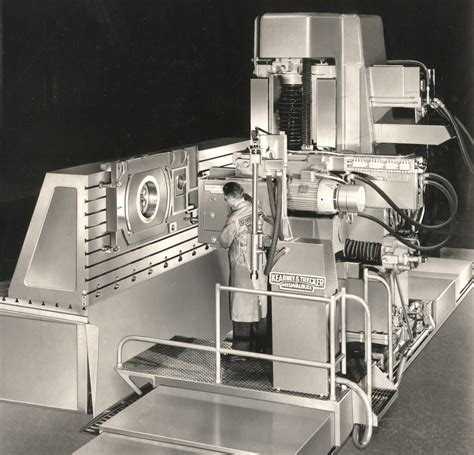cnc first generation machine The first CNC machine, a Cincinnati Hydrotel milling machine retrofitted with a computer control system, was introduced in the early 1960s. As computing technology advanced, CNC systems evolved from punch-card readers to more sophisticated computer interfaces.
We’ve been involved in manufacturing steel storage cabinets for over 85 years. Key .
0 · when did cnc machining start
1 · john t parsons cnc machine
2 · james parsons cnc
3 · history of cnc machine pdf
4 · first cnc milling machine
5 · evolution of cnc machines
6 · cnc router history
7 · cnc machine history timeline
With Tripar’s vast CNC capabilities and experience, we manufacture a wide range of sheet metal components through laser cutting, punching, bending, forming, spot welding, shearing, riveting, clinch joining and .
Many of the commands for the experimental parts were programmed "by hand" to produce the punch tapes that were used as input. During the development of Whirlwind, MIT's real-time computer, John Runyon coded a number of subroutines to produce these tapes under computer control. Users could enter a list of points and speeds, and the program would calculate the points needed .
Parsons invented CNC machining around 1948 in Michigan, USA. His vision was to improve the production of complex parts like helicopter blades, which required precision and efficiency. By collaborating with the . The first CNC machine was credited to James Parsons in 1949. Parsons was a computer pioneer who worked on an Air Force Research Project. The research was on how to produce helicopter blades and better aircraft skin.The history of numerical control (NC) began when the automation of machine tools first incorporated concepts of abstractly programmable logic, and it continues today with the ongoing evolution of computer numerical control (CNC) technology.
Parsons invented CNC machining around 1948 in Michigan, USA. His vision was to improve the production of complex parts like helicopter blades, which required precision and efficiency. By collaborating with the Massachusetts Institute of Technology (MIT), Parsons created a numerically controlled machine tool that could precisely cut complex shapes.The first CNC machine, a Cincinnati Hydrotel milling machine retrofitted with a computer control system, was introduced in the early 1960s. As computing technology advanced, CNC systems evolved from punch-card readers to more sophisticated computer interfaces. The first NC machine had its origins in similarly operated punch-tape devices from the previous century. In fact, equipment using punch tape or cards developed long before the first NC machines, but the technology had a decisive influence on the original NC machine. The first CNC machine, an experimental milling machine, was born out of a collaboration between John Parsons and Frank L. Stulen at Parsons Corporation in Traverse City, Michigan, in 1952. Their work centered around producing helicopter blades with .
CNC machining stands as a pillar of modern production, offering unparalleled precision, efficiency, and versatility. This article traces the evolution of CNC machining, exploring its historical roots and delving into its contemporary applications and the promise it holds for the future. In 1952, Richard Kegg, in liaison with MIT, created the first CNC milling machine, Cincinnati Milacron Hydrotel. In 1958, five years after that, he patented ‘Motor Controlled Apparatus for Positioning Machine Tool.’ Here, we look at four essentials: early machine tools, punched cards, servomechanisms, and the Automatically Programmed Tool (APT) programming language. First, a shout out to what is widely.
The first generation in 1952 utilized tubes. The second generation in 1959 employed transistors. The third generation in 1965 incorporated small-scale integrated circuits. Currently, the hard logic CNC system with hardware connections from the first stage is largely obsolete. The first CNC machine was credited to James Parsons in 1949. Parsons was a computer pioneer who worked on an Air Force Research Project. The research was on how to produce helicopter blades and better aircraft skin.The history of numerical control (NC) began when the automation of machine tools first incorporated concepts of abstractly programmable logic, and it continues today with the ongoing evolution of computer numerical control (CNC) technology. Parsons invented CNC machining around 1948 in Michigan, USA. His vision was to improve the production of complex parts like helicopter blades, which required precision and efficiency. By collaborating with the Massachusetts Institute of Technology (MIT), Parsons created a numerically controlled machine tool that could precisely cut complex shapes.
The first CNC machine, a Cincinnati Hydrotel milling machine retrofitted with a computer control system, was introduced in the early 1960s. As computing technology advanced, CNC systems evolved from punch-card readers to more sophisticated computer interfaces.
The first NC machine had its origins in similarly operated punch-tape devices from the previous century. In fact, equipment using punch tape or cards developed long before the first NC machines, but the technology had a decisive influence on the original NC machine. The first CNC machine, an experimental milling machine, was born out of a collaboration between John Parsons and Frank L. Stulen at Parsons Corporation in Traverse City, Michigan, in 1952. Their work centered around producing helicopter blades with .CNC machining stands as a pillar of modern production, offering unparalleled precision, efficiency, and versatility. This article traces the evolution of CNC machining, exploring its historical roots and delving into its contemporary applications and the promise it holds for the future.
when did cnc machining start
In 1952, Richard Kegg, in liaison with MIT, created the first CNC milling machine, Cincinnati Milacron Hydrotel. In 1958, five years after that, he patented ‘Motor Controlled Apparatus for Positioning Machine Tool.’ Here, we look at four essentials: early machine tools, punched cards, servomechanisms, and the Automatically Programmed Tool (APT) programming language. First, a shout out to what is widely.
john t parsons cnc machine
metallic box packaging

metallic device box

james parsons cnc
$3,210.00
cnc first generation machine|cnc machine history timeline